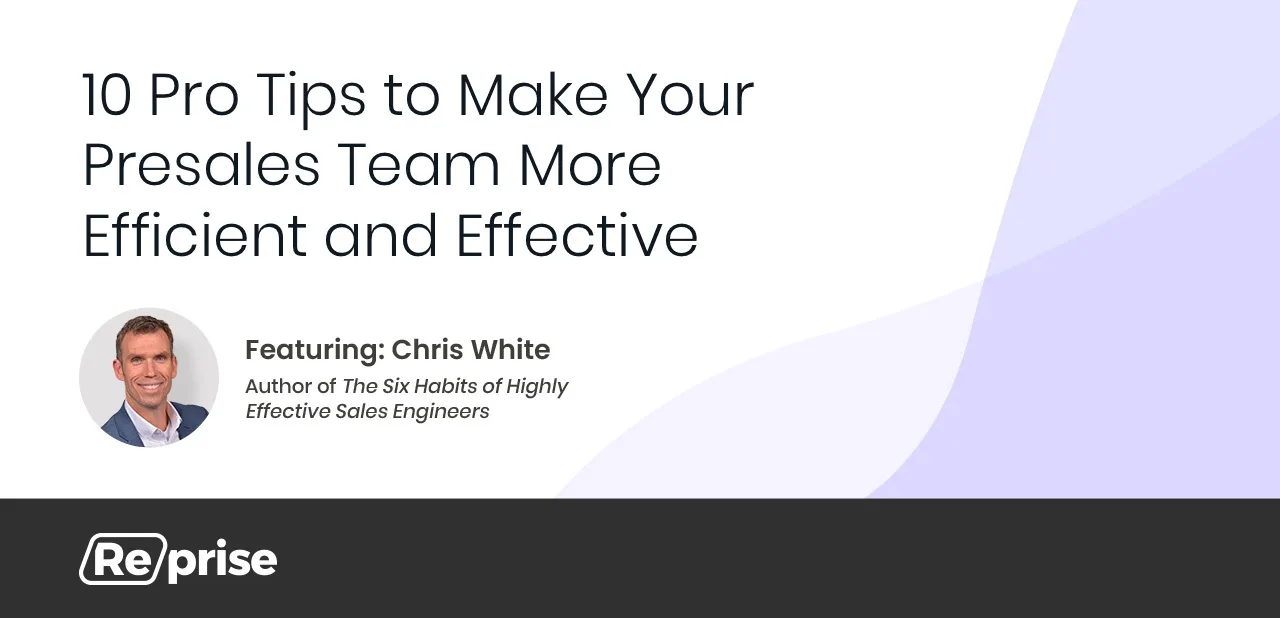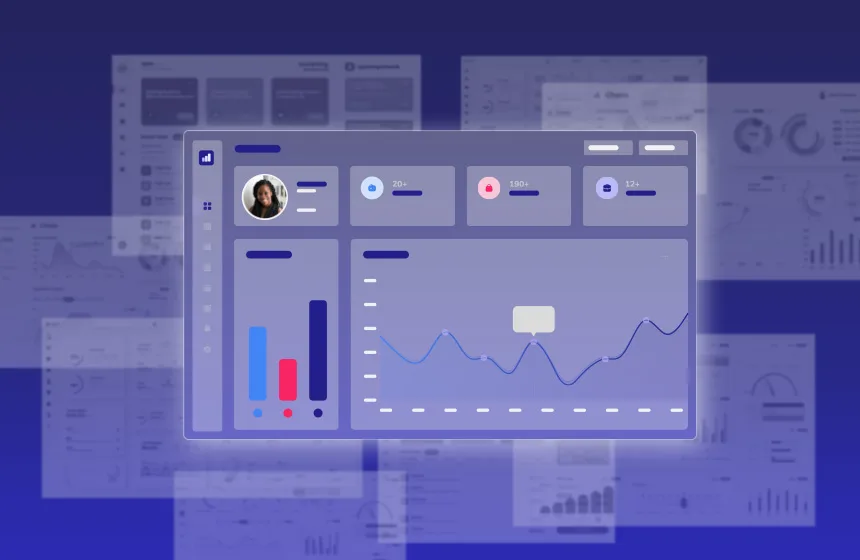Accelerate deals and increase win rates with the leading enterprise AI demo platform.
10 Pro Tips to Maximize Presales Team Efficiency

February 12, 2025
Table of Contents
As a presales leader, how do you guide your team to achieve their goals, without wasting time or resources? We spent some time with Chris White, the founder of TechSalesAdvisors and author of The Six Habits of Highly Effective Sales Engineers to get his tips for success. With a more than 30-year career in technical sales and consulting, he’s worked with thousands of sales engineers (SEs), and built a successful framework for delivering winning sales demos.
Let’s explore 10 of his top tips for presales leaders, ranging from evaluating your team’s current state, to planning ahead, to measuring success. As an added bonus, we’ll share some of our biggest secrets for delivering winning demos that close deals — without the time and toil of a homegrown demo environment.
1. Get smart about prioritizing your objectives
2. Watch for these sales collaboration red flags
3. Address skills gaps early and often
4. Know the goal and eliminate waste
5. Use technology as an extension of your team
6. Get proactive about your demo assets
7. Look out for team members that seem “uncoachable”
8. Identify your most meaningful metrics for success
10. Coach team members to lead with value
1. Get smart about prioritizing your objectives
When it comes to planning ahead, it’s all too easy to get distracted by a wide variety of objectives. Chris recommends aligning your goals with what’s most important to your organization:
One of the most important things for presales leaders to think about is objective-setting. What are the goals you want your team to achieve? Understand the goals or outcomes you want to measure. Without a benchmark, you don’t know how effective you’re going to be.
For example, do you want to improve communication and collaboration with your sales counterparts? Improve opportunity responsiveness? Prioritize professional development? Attain quota or drive revenue? Improve the overall customer experience?
All of these are great objectives to consider, but keep in mind that there’s only so much time in a day. Prioritizing is key. For example, for one of my clients, an important part of supporting sales in hitting their numbers was contributing to a consumption-based revenue model. Instead of prioritizing new signups alone, this team knew they needed to focus on coaching prospects and current customers to increase their usage of the product. Think about similar goals your organization might have, and map your presales objectives back to those.
2. Watch for these sales collaboration red flags
What are some of the biggest red flags to look for in the partnership between presales and sales? Chris says to remember that collaboration is key, and often communication issues go both ways:
I like to look at the SE’s level of proactivity. How proactive are they in making sure they have the information they need, and are prepared for meetings? Getting involved too late in the sales cycle can be a red flag.
Another issue can arise if the SE is not effectively negotiating with the AE for what they need, or pushing back critically when things aren’t working. Not taking ownership for your own success is taking the easy way out. Leaders need to coach these team members to identify what they can do to influence the situation, instead of playing the role of victim.
It’s important for SEs to be more proactive about communicating with AEs. In a perfect world, they would have established rules of engagement before they start taking on prospect meetings. That means setting expectations around the discovery process, the amount of time needed to prepare for demos, following up after meetings, and more.
With that said, SEs need to remember to be flexible in their approach. Trust, respect, and communication must be established in both directions. Both AEs and SEs need to appreciate the difficulty of one another’s jobs. Effective communication requires being proactive, direct, and ensuring that both parties are on the same page.
3. Address skills gaps early and often
An effective presales leader can help their team hone in on the areas that need most improvement. Here’s the question Chris says is most important to helping identify those skills gaps in the first place:
“Are we closing winnable deals?” If the answer to that question is “no,” there may be a fixable problem with one of the steps that SE is responsible for, for example, the demo. Are you getting to the demo but failing to move forward and get to a close? Are you failing to move to a POC? Are your demos too focused on the technology, or are they irrelevant to the buyer?
There are two goals of any demo. First, you want prospects to understand what they’re seeing and how the solution will solve their problems, or help them achieve their goals. Second, you want them to be impressed and convinced that yours is the best solution for them. If neither of these goals are achieved, there is a problem with the demo or the skillset of the person giving the demo. When they engage in technical discovery, are they uncovering the information necessary to present the solution in a meaningful way? Based on discovery, are they able to effectively position the problem and determine what should be demoing? Do they need to establish a better collaboration with sales?
4. Know the goal and eliminate waste
Strategic planning can seem daunting at first, but creating an actionable plan doesn’t have to be difficult. Here’s what Chris recommends for optimizing your team’s efficiency and effectiveness:
Start by identifying the goals or outcomes that you want to measure. Without that baseline, you don’t know whether or not you’re effective. Know the goal and eliminate waste.
I’ve put together a presales enablement framework that can help any team create an actionable plan to meet their goals. View this framework in the lens of your own goals by thinking: What do we need to do to be effective in meeting our goals? How are we wasteful with time, effort and resources in context with that objective? From there, you can pull from certain levers within this framework to increase knowledge, develop skills, create collateral, improve processes and technology, or develop programming that will advance our team holistically.
5. Use technology as an extension of your team
Here’s Chris’ best advice when it comes to choosing technology: Pick a tool or solution that enhances your team, and helps them win back time in their day. In doing so, you’ll find you can create a competitive advantage for your entire sales organization:
In the past three or four years, there has been an explosion in the number of tools available for SEs. One of the most important categories presales leaders should be exploring is demo automation. A demo creation platform can help presales teams scale their resources more effectively, and help AEs fly solo on first call demos.
In fact, I predict that by 2030, organizations who are not using demo automation will be at a competitive disadvantage. Demo automation is a fast-growing category so I encourage companies to take into account the following purchase consideration questions:
- What scenarios are most important to prepare for?
- Who will need to create and/or own demo assets?
- Do you need to replicate product functionality?
- Do your demos involve third party software?
- How will product upgrades or changes impact your demo assets or demo environment?
- What analytics, insights, or metrics do you need?
There are many other categories of presales technologies, and prioritizing them is a matter of deciding where your team needs to achieve greater efficiency or scalability.
6. Get proactive about your demo assets
One way SEs can get more efficient with demos is to build a library of demo assets in advance. These demo libraries can be sorted by industry, use case, pain point or other areas — and AEs can customize them as new prospect calls arise. Here’s how Chris recommends being proactive with your demos:
SEs by nature tend to be adrenaline junkies. They love a call to action and will parachute into technical conversations with prospects. An area where we tend not to be as strong is non-urgent, yet critically important tasks. That’s where a proactive plan can serve you well.
For example, can you prepare content for a demo library in advance, rather than in response to a meeting request? A demo library focused on specific industries or use cases can save you a ton of time, and you can still tailor them to specific prospects’ requirements or pain points. Or, as a part of your preparation process, can you create send-ahead introductory demos? What about interactive demos as leave-behinds for committee decision-makers?
Presales teams all too often live in a world of reactivity. The more you can create libraries and scripts in anticipation of what’s coming, the more productive and effective your team will be in the months and years to come.
7. Look out for team members that seem “uncoachable”
Coaching is a major part of a presales leader’s life, but certain types of team members might be more open-minded to feedback than others. Here are some qualities Chris recommends considering to determine who’s most coachable:
How popular is a given SE is with the sales team? What kind of feedback are they getting from sales? Are they receiving complaints or accolades? Are they consistently sought out by account executives—even those on different teams, or are they struggling to keep their calendar full?
Another intangible is the desire to improve. Do the individuals on the team consistently demonstrate a desire to change? Or are they set in their ways and show resistance to coaching and new ideas?
As a certified instructor with ASLAN Sales Training, I teach my clients a “Quad Coaching Chart” [see image below], in which I invite sales and SE leaders to rate the members of their team on two dimensions: Results (above the line or below the line) and Desire to Improve (low or high).
- Independents are those who achieve the results but demonstrate a lack of desire to improve.
- Achievers are those who achieve the results AND demonstrate a strong desire to improve consistently.
- Strivers are those who are not yet achieving the desired results BUT do demonstrate a strong desire to improve.
- Detractors are those who are not achieving the desired results AND also demonstrate a lack of desire to improve.
It’s important to note: Desire to improve is based on activity, not attitude. For example, some people have the right attitude and say all the right things, but when you give them an assignment to improve in a specific area, nothing happens. That’s not desire. That’s lip service.
Here’s the problem. As managers, we tend to focus on results, and then channel our coaching energy on those who aren’t achieving the desired results. What happens? Detractors continue to underachieve because they lack desire to improve. And Achievers feel ignored and leave. (Have you ever wondered why good people who are hitting their numbers leave for “better jobs”?)
Want to improve both your efficiency AND effectiveness with your coaching? Shift your focus towards developing those individuals on the right side of the chart—those that demonstrate the desire to improve, regardless of results.
8. Identify your most meaningful metrics for success
Remember how we talked about getting smart with your objectives? The same holds true for how you measure success. Measurement for measurement’s sake might be counterproductive. Here’s what Chris recommends:
Measurement is often a big challenge for SE leaders; for sales leaders it is much easier. However, one of the most important metrics for both sales and SE leaders is: Are we hitting quota or not? Other important factors include: Where and how are we spending our time? Do we have an appropriate balance between customer-facing vs. non-customer-facing activities?
Consider metrics such as attach rates: Of the opportunities in the pipeline, how many of them involve SEs? Of those that involve SEs, what is the close rate of those opportunities? Look at discovery: What percentage of discovery activities are SEs involved in, and what are the close rates of those opportunities? You can also track average deal size: What is the average deal size of those that involve SEs vs. those that do not?
Above all else, SE leaders should ensure that the metrics they’re tracking are meaningful. Are they equipping their team members to provide the data necessary to produce a meaningful metric? Are there potential metrics that are driving inefficiency? For example, if leadership is tracking the number of demos an SE does on a monthly basis, is it possible SEs are just signing up for demos (whether they are qualified or not) to hit a personal quota? Your metrics should align with what is best for the business.
9. Build a culture of trust
Collaborations with other presales or sales team members must be built upon a solid foundation of trust. Here are two of the most important characteristics of highly effective presales teams, according to Chris:
One is a high level of trust. When someone is assigned to an engagement or an opportunity, they don’t question it, they don’t push back, and they are eager to jump in. A lot of time and effort is wasted in second-guessing strategy and processes, so a high level of trust between the SE leader and SE is needed — as well as between the SE and AE.
Two, they have effective communication. What does that look like? There is a structure for people to elevate issues and concerns. There is a culture of providing necessary feedback. People are not afraid to have difficult conversations.
10. Coach team members to lead with value
A common pitfall for SEs is to dive into the technical details, without first setting the stage as to why a product might be valuable to a prospect in the first place. Value-based selling is a challenge, but according to Chris, effective coaching goes a long way:
Make sure your team understands the value proposition and the unique benefits of the solution vs. the competition vs. the status quo. Are they equipped with the right knowledge and information in order to lead with value and sell with a value mindset?
Equip them with demo templates, scripts, scenarios, demo flows, and collateral that emphasizes the value, outcomes, and benefits — over the technical details and the how-to. SEs need to invest the time to either review demo calls, sit in on demos, and/or do mock demo training and role playing. Leaders then need to provide feedback through one-to-one coaching.
Here’s the unfortunate truth about coaching: There are no shortcuts. I can be highly effective in coaching, but if I do so at the expense of my other responsibilities, I’m effective but not particularly efficient. Most leaders are too efficient in coaching. They provide quick, flash-in-the pan feedback without taking the time to first understand and evaluate the performance of their team members.
Regardless of the coaching model you follow (there are a number of best practices in the market) leaders need to be trained on how to coach. If they aren’t, their people suffer. While SEs may be getting feedback, it doesn’t mean they are getting effectively coached. One common mistake is giving SEs 10 things they should do differently. Nobody can correct 10 things at once. Instead, managers need to hone in on one skill or technique, and help them focus until they develop competency. Then, move on to another area for improvement.
Bonus Tip: Set your team up for success with a demo creation platform
We’ve touched on how technology can serve as an extension of your team, and the importance of proactivity when preparing for demos. A demo creation platform like Reprise can go a long way when it comes to saving time and equipping salespeople with the demos they need to run successful calls with prospects.
According to the 2024 Presales Landscape Report, here are some of the most time-consuming activities for SEs:
- Demoing to unqualified prospects: Nearly a quarter of SEs (23%) say more than half of their weekly demos are unqualified.
- Preparing for demos: 50% of SEs spend an average of 1-3 hours per week preparing demos. Some scripted demos require 40+ hours of prep alone!
- Maintaining the demo environment: 79% spend more than an hour per week cleaning/maintaining their demo environment; 16% spend between 3-10 hours. On the high end, that’s a whopping
- 21 days per year wasted for these high-value employees!
A demo creation platform can help teams avoid these common time-wasters. Here’s how.
- Qualifying prospects early in the sales cycle: When product tours are available to prospects on your website, your sales organization is more likely to get a pipeline of pre-qualified leads. In fact, customers using Reprise at the top of the funnel experienced a 60% uplift in average website interactions converted to leads, and a 50% increase in conversion from lead to pipeline. A bonus? When prospects reach sales, they’re already knowledgeable about your solution.
- Increasing presales team capacity: Rather than giving a high volume of standard, low-converting demos, presales teams can prepare a high-performing demo library in advance, which can be easily customized by AEs using no-code tools. Reprise users leverage easy-to-use customization tools to increase their demo capacity by 400%, without additional SE resources.
- Providing a stable and scalable demo environment: SEs spend an inordinate amount of time maintaining sandboxes and homegrown demo environments. With a demo creation platform like Reprise, SEs can faithfully render their products without the instability of unpredictable crashes or costly anonymization mistakes. Plus, Reprise users experienced a 75% lower total acquisition cost, due to a reduction in hosting and maintenance cost associated with running multiple demo environments.
Want even more secrets of highly effective presales teams?
Check out our webinar with Chris White: Effective or efficient? 5 ways solution engineering teams can achieve balance and make it happen in 2024






